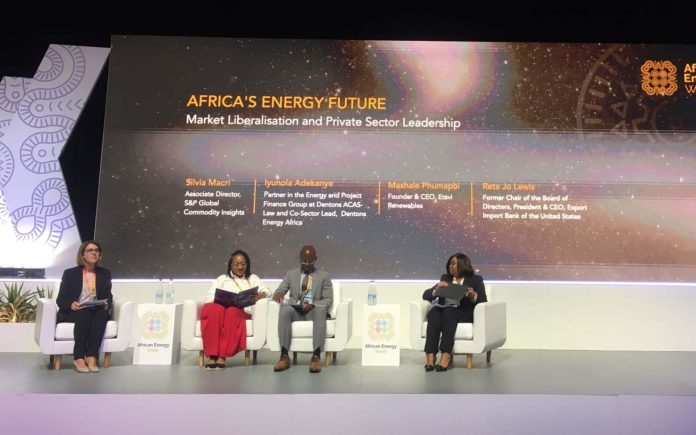Private-sector confidence in market liberalization is beginning to shape a new narrative about Africa’s energy future, but the optimism voiced at Africa Energy Week 2025 in Cape Town this week (29 Sept – 3 Oct 2025) came with a clear rider: reform alone will not attract capital unless it is paired with bankable projects, predictable rules and the capacity to absorb investment at scale. That was the theme of a panel titled “Africa’s Energy Future: Market liberalization and Private Sector Leadership,” where lawyers, developers and financiers sketched out why regulatory change matters and where it can fall short in practice.
Underlying the debate is a simple fact: demand for electricity across the continent is set to grow rapidly this decade, and in many scenarios it rises by multiples compared with today’s consumption. International modelling shows that, depending on assumptions about industrialization, access and electrification policies, Africa’s power needs could more than double by 2040, and in higher-growth scenarios expand still further. That prospect is what makes market access and competition commercially interesting; it is also what makes the consequences of faulty implementation economically painful.
Nigeria’s Electricity Act of 2023 was repeatedly held up at AEW as a live example of reform that changes the risk calculus for investors. By devolving regulatory responsibilities from the federal regulator to state authorities, the law aims to create smaller, more manageable markets and clearer entry points for power developers. For investors, the attraction is operational: negotiating with a state regulator on licensing, tariffs and operations can be simpler than navigating a centralised, monolithic framework. The caveat expressed by speakers was familiar — states need the institutions, budgets and technical skills to make their side of the bargain credible. Where those capacities are weak, reform can increase fragmentation rather than reduce risk.
South Africa’s Renewable Energy Independent Power Producer Procurement Program was cited as an instructive counterpoint. The program’s competitive tenders and standardized contracts helped unlock private investment in wind and solar at scale and demonstrated how structured procurement can produce bankable projects. At the regional level, institutional platforms such as the Southern African Power Pool are increasingly important because they enable cross-border trading and shared planning, functions that make larger projects and transmission corridors financially viable. Initiatives to mobilize transmission funding, including a regional transmission financing vehicle, illustrate the kind of project-level innovation investors want to see when they consider long-term commitments.
Read also: Russia’s new deal with Sudan: Railways, Airports, and the shifting map of African infrastructure
Financiers in the room were blunt: liberalization creates opportunity, but lenders underwrite projects, not policies. Reta Jo Lewis, drawn on during the panel for her experience at the U.S. Export-Import Bank, reiterated that bankable projects require credible sponsors, reliable revenue streams and realistic risk allocation. That is why project preparation facilities, standardized procurement templates and de-risking instruments such as guarantees and blended finance are not bureaucratic niceties but prerequisites for scaling private capital across the continent. Without these mechanisms, even well-crafted laws will struggle to convert investor interest into deployed capital.
The conversation at AEW also reflected a broader ecosystem of finance and policy signals. Multilateral and regional banks, and newer funds designed to underwrite cross-border transmission, are responding to the same diagnosis: markets need both policy clarity and financial architecture to move from isolated deals to pipelines. The recent pledges by multilateral actors to support electrification and the emergence of regional transmission funds point to a maturing ecosystem, but the sums committed to date remain modest compared with the scale of the task. That gap explains why private developers stress the need for blended structures that combine concessional capital, political risk insurance and competitive procurement to lower the cost of capital and crowd in commercial lenders.
Practical examples from the continent show both the promise and the limits. Where governments have paired clear tenders with credible offtake arrangements, as in successive rounds of South Africa’s IPP program, private capital has moved quickly. Where regulatory change has outpaced institutional readiness, investors have delayed commitments or demanded larger risk premia. The Southern African Power Pool’s ongoing work to standardize market rules and expand transfer capacity is a reminder that connectivity and regional markets can multiply the value of individual projects, but that building the necessary transmission backbone requires coordinated national planning and patient capital.
Read also: Global policy shifts hit South Africa’s auto industry as ford cuts nearly 500 jobs
For policymakers the message is therefore concrete; Liberalization is necessary but insufficient. To translate policy into power, governments must invest in the preparatory work that makes projects bankable: clear grid-connection procedures, transparent tender frameworks, credible counter-parties for power purchase agreements, and targeted guarantees where sovereign capacity is weak. They must also plan markets so they do not simply fragment distribution into patchworks of small jurisdictions that raise transaction costs. Private investors can shoulder construction and operational risk when they see predictable revenue and enforceable contracts; absent that, even eager financiers step back.
The stakes extend beyond kilowatt-hours. Liberalized markets that succeed can expand access, create industrial clusters and reduce the cost of doing business. They can also accelerate the continent’s shift to renewable sources if procurement and transmission are aligned with clean-energy targets. However, the transition must be managed so that risk is shared intelligently: reform requires sequencing, enforcement, and an ecosystem of institutions that can sustain long-term investment decisions. That is the practical challenge AEW delegates left the stage with, and the yardstick by which market liberalization will be judged in the coming years.
If Africa’s policymakers and their partners succeed in knitting reform together with project preparation and de-risking instruments, the private sector’s optimism will prove durable. If not, the continent will continue to experience intermittent waves of interest followed by periods of retreat, as investor confidence ebbs at the sight of weak enforcement or unclear market rules. The AEW conversations made one thing clear: liberalization opens doors, but the next step, turning laws into bankable projects, is where Africa’s energy transition will be won or lost.
Subscribe to our newsletter to get more updates on Africa’s energy sector, here.






